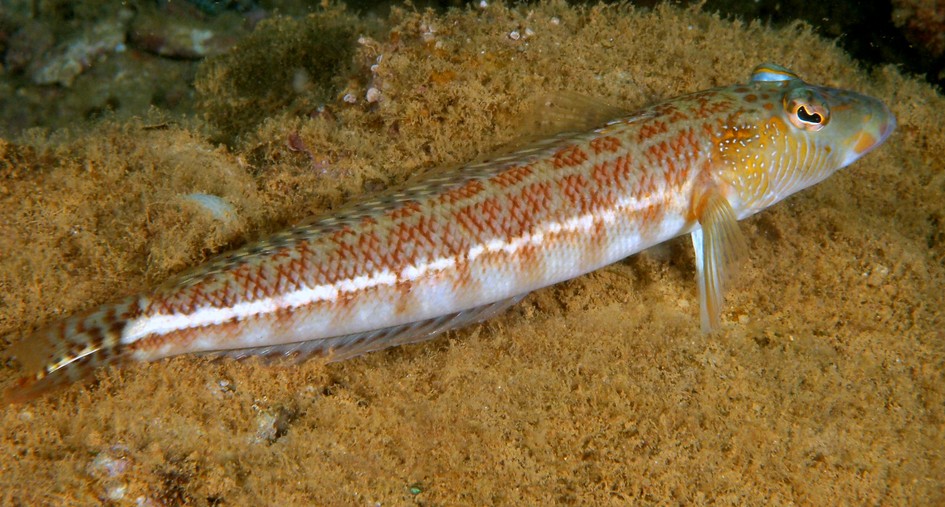PARAPERCIS XANTHOZONA - (BLEEKER, 1849)
Actinopterygii (Gigaclass) > Actinopteri (Class) > Teleostei (Subclass) > Labriformes (Order) > Uranoscopoidei (Suborder) > Pinguipedidae (Family) > Parapercis (Genus)
Peppered grubfish, Grubfish, Whitestrip Sandperch, Yellow-spot grubfish, Yellowbar sandperch, Yellowspot grubfish, Kokuten-toragisu, オジロトラギス, 紅帶擬鱸, Cá Lú vàng,
Synonymes
Neopercis xanthozona (Bleeker, 1849)
Parapercis atromaculata (Fowler, 1904)
Parapercis dorsonebulosa (Martin & Montalban, 1935)
Parapercis xanthosoma (Bleeker, 1849)
Percis xanthozona (Bleeker, 1849)
-------------------------
Description
Dorsal spines (total): 5; Dorsal soft rays (total): 21; Anal spines: 1; Anal soft rays: 17-18; Lateral-line scales: 56-60; Predorsal scales: about 15. Max length: 23.0 cm TL. Depth range: 10 - 28 m.
Color
Has a white mid-lateral stripe from the upper pectoral base to the tail. Males have narrow diagonal lines on the cheek. Fine spotting over the back. Scales on back above white stripe with dark edges, many with outer half dark brown. An orange-yellow bar at base of pectoral fins.
Etymology
Parapercis: from Greek prefix, para = resembling to + from Greek, perke = perch. Perch is a common name for fish of the genus Perca, freshwater gamefish belonging to the family Percidae.
xanthozona: from ancient Greek, xanthós = yellow + from Latin, zōnātus = belted, girdled, zoned. Referring to yellowish (sometimes white) wavy stripe from operculum to tail along middle of body.
Original description: Percis xanthozona Bleeker, 1849 - Type locality: Jakarta, Java, Indonesia.
Distribution
Eastern Indian Ocean, western Pacific: Myanmar, Andaman Islands and Indonesia east to New Caledonia and Fiji, north to Ryukyu Islands, south to Kimberley (Western Australia) and Northern Territory (Australia).
Biology
Found in shallow protected sandy areas near reefs of lagoons and bays, often amongst boulder. Carnivore - feeds on small fishes and benthic invertebrates.
Similar species
Parapercis albiventer (Ho, Heemstra & Imamura, 2014) - Reported from Western Indian Ocean: East and South Africa to Madagascar.
Last update: 4, September 2021
Peppered grubfish, Grubfish, Whitestrip Sandperch, Yellow-spot grubfish, Yellowbar sandperch, Yellowspot grubfish, Kokuten-toragisu, オジロトラギス, 紅帶擬鱸, Cá Lú vàng,
Synonymes
Neopercis xanthozona (Bleeker, 1849)
Parapercis atromaculata (Fowler, 1904)
Parapercis dorsonebulosa (Martin & Montalban, 1935)
Parapercis xanthosoma (Bleeker, 1849)
Percis xanthozona (Bleeker, 1849)
-------------------------
Description
Dorsal spines (total): 5; Dorsal soft rays (total): 21; Anal spines: 1; Anal soft rays: 17-18; Lateral-line scales: 56-60; Predorsal scales: about 15. Max length: 23.0 cm TL. Depth range: 10 - 28 m.
Color
Has a white mid-lateral stripe from the upper pectoral base to the tail. Males have narrow diagonal lines on the cheek. Fine spotting over the back. Scales on back above white stripe with dark edges, many with outer half dark brown. An orange-yellow bar at base of pectoral fins.
Etymology
Parapercis: from Greek prefix, para = resembling to + from Greek, perke = perch. Perch is a common name for fish of the genus Perca, freshwater gamefish belonging to the family Percidae.
xanthozona: from ancient Greek, xanthós = yellow + from Latin, zōnātus = belted, girdled, zoned. Referring to yellowish (sometimes white) wavy stripe from operculum to tail along middle of body.
Original description: Percis xanthozona Bleeker, 1849 - Type locality: Jakarta, Java, Indonesia.
Distribution
Eastern Indian Ocean, western Pacific: Myanmar, Andaman Islands and Indonesia east to New Caledonia and Fiji, north to Ryukyu Islands, south to Kimberley (Western Australia) and Northern Territory (Australia).
Biology
Found in shallow protected sandy areas near reefs of lagoons and bays, often amongst boulder. Carnivore - feeds on small fishes and benthic invertebrates.
Similar species
Parapercis albiventer (Ho, Heemstra & Imamura, 2014) - Reported from Western Indian Ocean: East and South Africa to Madagascar.
Last update: 4, September 2021
